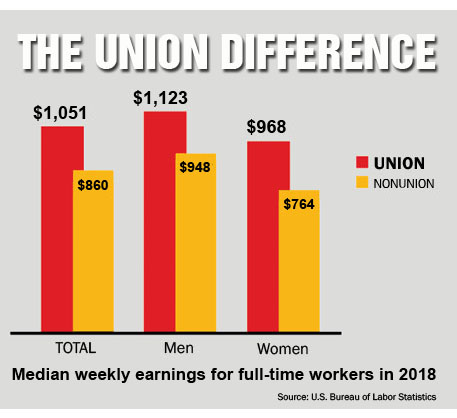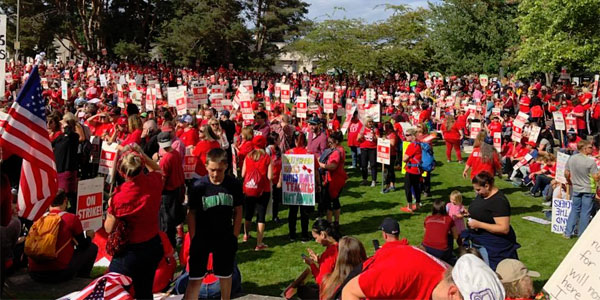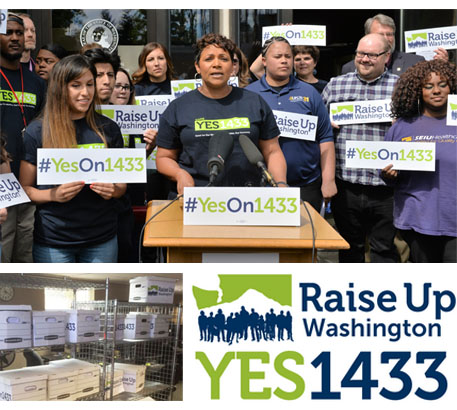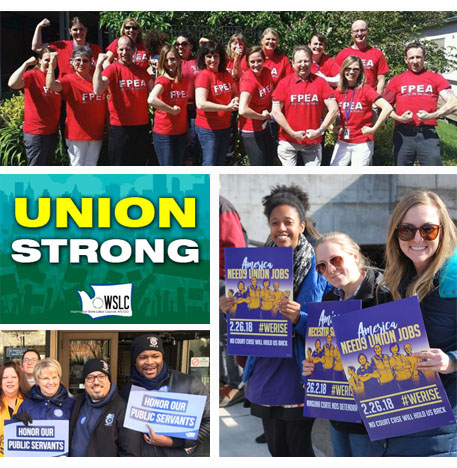OPINION
Union growth in Washington is good for all working people
 By LARRY BROWN
By LARRY BROWN
SEATTLE (Feb. 8, 2019) — The following remarks on the state of unions in Washington 100 years after the Seattle General Strike were delivered yesterday by Larry Brown, President of the Washington State Labor Council, AFL-CIO, at the Seattle City Council’s Housing, Health, Energy, & Workers’ Rights Committee, hosted by Councilmember Teresa Mosqueda:
—
I represent the largest labor organization in Washington state, with more than 600 union organizations and approximately 550,000 rank-and-file members.
A hundred years after what’s been called “labor’s most spectacular revolt,” I’m here to report that unions in Seattle and across Washington state are strong and getting stronger. Our state is bucking national trends, and more and more working people here are seeing the value of joining together in unions.
 The Bureau of Labor Statistics reports that the number of union members in Washington grew by 65,000 last year — a more than 10% increase. There are now an estimated 649,000 union members in our state, which represents 19.8% of the state’s workforce. That makes Washington the third most unionized state in the nation (behind Hawaii and New York). And we plan to keep growing until we’re No. 1.
The Bureau of Labor Statistics reports that the number of union members in Washington grew by 65,000 last year — a more than 10% increase. There are now an estimated 649,000 union members in our state, which represents 19.8% of the state’s workforce. That makes Washington the third most unionized state in the nation (behind Hawaii and New York). And we plan to keep growing until we’re No. 1.
This is great news for union members because that same Bureau of Labor Statistics report found that union wages are 22 percent higher than non-union wages on average. Full-time union members make more than $54,600 per year on average, which is about $10,000 more than non-union workers. That’s the power of joining together with your co-workers to negotiate a fair return on your work.
And that’s the power of solidarity. When organized workers are fed up with unfair treatment or low pay, they can walk off the job just like they did 100 years ago.
In the past year, public school teachers and support staff across the state, heavy construction equipment operators in Western Washington, and school bus drivers in Seattle have all gone on strike. And all of them achieved important gains. In many other cases — as with the Westin Hotel workers, University of Washington academic student employees, and AMR’s emergency medical technicians – the threat of a strike helped win good contracts with wage increases and better benefit.

Striking teachers in Tacoma rallied Sept. 13, shortly before a contract agreement was reached.
The truth is, the increase in Washington’s union membership is great news for ALL workers — union and non-union. We fight for and win labor standards and protections that benefit everyone. Washington’s labor movement led the charge for raising the state minimum wage, allowing all workers to earn paid sick leave, and historic new family and medical leave benefits, just to name a few. The national “Fight for $15” originated right here in SeaTac.

Unions sponsored and promoted I-1433, which voters approved in 2016, to raise the state minimum wage to $13.50 and allow all workers in Washington to earn paid sick leave.
Unions advocate for quality public schools, affordable health care for all, and workforce training and development for the next generation of workers. Unions have protected and strengthened the state’s social safety nets for workers injured on the job or laid off through no fault of their own. We have partnered with community organizations to fight for immigrant rights, racial justice, and environmental protections, and against discrimination of all kinds.
What’s remarkable, though, is that unions in Washington have achieved these gains despite strong national headwinds.
Weak and outdated federal labor laws make is way too hard to form a union in this country. A multi-billion dollar union avoidance industry advises corporations to flout or ignore laws intended to protect the freedom to choose unions. They do so because the penalties for breaking these laws are cheaper than having to raise their wages and benefits.
That’s why, at the national level, union membership has dropped over the past few decades. And that decline precisely mirrors the steady decline of the American middle class. Wealth inequality is now at a level not seen since America’s Gilded Age.
It’s not because unions aren’t popular. Gallup approval ratings of unions have risen to 62 percent, while just 30 percent disapprove. About half of non-union workers surveyed say they would join a union right now if they could, which is significantly higher than it was a couple decades ago.
 But conservative politicians — with their campaigns bankrolled by billionaire industrialists, like the Koch brothers — have succeeded in discouraging unionization through so-called “right-to-work” laws. And the conservative majority in the U.S. Supreme Court continues to issue anti-union decisions. After last year’s Janus decision, which forces pubic employee unions to provide services to non-members for free, many were predicting the end of organized labor.
But conservative politicians — with their campaigns bankrolled by billionaire industrialists, like the Koch brothers — have succeeded in discouraging unionization through so-called “right-to-work” laws. And the conservative majority in the U.S. Supreme Court continues to issue anti-union decisions. After last year’s Janus decision, which forces pubic employee unions to provide services to non-members for free, many were predicting the end of organized labor.
But instead, here in Washington, we are growing. We’ve doubled down on internal organizing. We’ve re-engaged our members to make sure they understand the importance of sticking together and keeping their unions strong. And I think our membership growth in this state shows we’re succeeding.
So 100 years later in Seattle and throughout Washington, the struggle continues for the working class to get a greater share of the wealth they create. And despite serious headwinds from this century’s corporate bosses and political opponents, our state’s unions are winning important victories for the people of our state.
Watch yesterday’s entire Seattle City Council presentation by President Brown — also including presentations on the Seattle General Strike of 1919 by University of Washington professor James Gregory, UW labor archivist Conor Casey, and MLK Labor’s Nicole Grant — (starting at 38:00).





